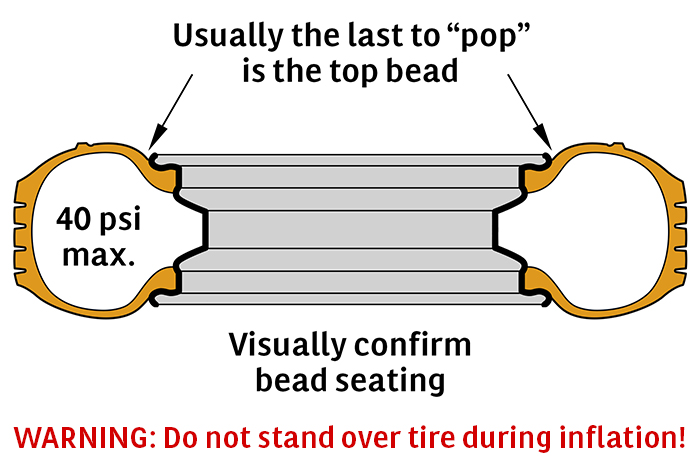Stretched Tires: A Balance Between Style and Driving Safety
Posted by Agota Szabo on Jul 24th 2023

You might have heard the term "stretched tires" before. But, what are stretched tires?
They are the stylish tire alternations every car modification enthusiast is striving for. Yet, when not done or used properly, they can be just as dangerous.
What is Tire Stretching?
A stretched tire is basically any tire that sports a narrower tread width compared to the rim it is mounted on. This results in the rim sticking out of tire, even with slightly stretched tires.
Often, tires are stretched in order to create the show-style or hellaflush aesthetic of sports cars. It makes the rims the center of the style, minimizing the tire sidewall areas showing.
Why do People Stretch Tires?
Drivers may want to achieve different outcomes with stretch wheels, but the bottom line is the same. Stretching tires on rims is primarily done for aesthetic reasons.
It is a well-loved style among sports car enthusiasts, especially on the excessive-camber scene. The stretched tire fitment gives drivers the option to build and modify their stance vehicles, creating a unique look each time.
However, the stretch wheel look is just that... a style to create. It does not provide benefits when it comes to tire and vehicle performance. In fact, extreme tire stretches can decrease traction and handling, but more on that later.
What is a Stance Car?
A stance car is a car customization style that uses lowered suspension, stretched tires, and a negative chamber to create the vehicle's aesthetic. In other words, the car's body is lowered, the stance wheel stands at an angle, and the tires are stretched.
We have already discussed "What is a stretched tire?". Stanced tires are almost the same. These are also stretched tires on trucks or sports cars, but they are combined with the negative chamber wheel placement to create a cohesive sporty look.
So, why do people stance cars? Mostly for the aesthetic it offers. The style varies from extreme stance car applications to milder ones, but all of them result in a unique approach to car fashion.

How to Stretch Tires?
If you wish to create the rims sticking out of tire style, it is best to consult a professional. It can be extremely dangerous to stretch tires on rims at home as you need flammable substances to mount such tires.
If you absolutely have to know how to stretch tires on rims, keep reading. But, we cannot stress this enough: do NOT go about stretching tires without proper safety precautions, safety gear, and a fire extinguisher.
Mounting Stretched Tires
During the stretching process, a smaller tire is expanded to fit a larger wheel. A 1 to 3-inch difference between the tire and wheel width is commonly used. We suggest contacting a professional with experience in stretching tires to do this process for you. However, below is a step-by-step outline of how to stretch a tire on a rim.
Before you start, make sure you have the proper safety equipment. These include fireproof masks, gloves, and suits, as well as a working fire extinguisher. Proceed at your own risk.
- Select the wheel stretch combination you want to work with. Be sure to get good tires for stretching that will be able to withstand the pressure.
- Using a tire lubricant, or soapy water, lubricate the tire bead generously. This helps the tire bead slide on the rim better.
- Mount the tire onto the wheel and place them on the ground. At this step, the tire is not sealed to the rim yet.
- In order to seal the tire and have it correctly sit on the rim, a controlled burst of fire needs to be used. This is a dangerous technique that is known as the fire-seating technique. Flammable gas is sprayed inside the tire. Push air inside it as well and light it up. A small explosion is the result, which stretches the tire due to the heat and the pressure increase.
- Quickly inflate your stretched truck tires with an air compressor. This keeps the tire bead properly sealed to the wheel.
- Balance the stretched tires if you have the machinery for it. If not, mount the tires on the vehicle and take them to be balanced at a garage.
How Much Tire Stretch is Safe?
In most cases, a slight stretch of the tires will not compromise the vehicle's performance. So, why are stretched tires dangerous?
The bigger the stretch of the tires, the higher the risk of some issues arising. The risks include tire blowouts, deflating, a debeaded tire, irregular tire wear, or damage caused to the alloy rims. The performance of tires stretched to the max is also greatly diminished.
Additionally, since the tire bead is not seated on the wheel as it is intended, rough, damaged, or uneven roads can result in sudden deflation. This can easily happen when the tire debeaded while driving.

Stretched Tires vs Regular
Due to their dangerous nature, stretched tires have their time and place. When talking about the stretch tires vs normal tires debate, it goes without saying that for safe, everyday driving stretched tires are not ideal.
Stretched tire and wheel combos are ideal for drivers building a show car when the aesthetic requires more wheel to show than tire. If your end goal is a specific fitment style and performance risks are not a concern, stretched tires are ideal for you.
However, even with sports cars and trucks, if you need normal performance it is not a good idea. With stretched tires, safe high speed performance is not possible. Harsh roads and long travels will also cause problems. Additionally, they reduce the tires' road traction, further ruining their driving safety.
Fuel Economy, Traction, and Handling of Stretched Tires
Among the many downsides of the practice of stretching tires is the loss of driving safety. These are not safe tires when it comes to regular, everyday driving. And there is a reason behind it.
Even good tires to stretch have narrow footprints once they are mounted. As the tire has a smaller contact patch, it is unable to provide the road grip necessary to ensure safe performance. Furthermore, if the wheels are mounted in a negative chamber, it reduces the contact area even more.
This leads to ruined controllability as well. The tires are unable to provide the necessary steering responses and accuracy, and structural stability. It also decreases the stretch tire's cornering and braking capabilities, which reduce the driver's control over the vehicle. High speed driving is out of the question.
Another issue related to performance is fuel economy, which is also ruined by stretched tires. As the wheels are larger, the vehicle's engine needs to work harder to keep the tires in motion. This significantly increases the rolling resistance, and in turn the vehicle's fuel consumption.
Sacrificing Durability and Tread Life
Even the best tires for stretching will have significantly shortened life spans when mounted on stance cars. No stretched tires guide should leave out the extreme conditions these models face. They are made to do things they are simply not manufactured for.
As these tires are mounted on wheels with a negative chamber, only one side of their footprint will be in contact with the road. This places the entire vehicle weight and driving pressure on just that tread area, significantly accelerating its wear. It also leads to irregular wear, as the pressure cannot be evenly distributed.
Stretching the sidewall of the tires also leads to structural damage. Stretched tires develop tread and sidewall bulges (bubbles) more quickly and frequently. Cracking tread elements and exposed wires and plies are problems that can occur as well.
The combination of these elements significantly shortens the service life of stretched tires.
Is Stretching Tires Bad?
As long as drivers are aware of the dangers and they don't go overboard, stretching tires is not bad. These tires have their limitations and using them for everyday driving is out of the question. Yet, there is a time and place for them - as mentioned before.
Of course, running stretched tires will always be more dangerous than using normal tires, but their applications are also different. You won't put a stretch wheelset on the vehicle you take your kids to school with. So, as long as these tires are used responsibly, are not overly stretched, and you know the possible dangers, they can be a good aesthetic choice for your vehicle.

Safety Concerns of Tire Stretching
So, after all of this, are stretched tires safe to use? Yes and no!
We cannot tell you if it is worth it or not. But, it goes without saying that tire stretching is a hazardous venture. From the actual process of stretching tires to their diminished performance, these tires pose a problem. However, when they are handled with care and recognized for what they are (an aesthetic choice) the risk factors are within reason, albeit pricey.
"Normal" risks for stretched tire models include the debeading of the tires, tread and sidewall damage - such as sidewall bubbles, tread separation, or tire blowouts. The stretched sidewalls' load durability is also significantly lessened and tire belt failure is common.
All of these issues can lead to accidents, which can be fatal. For this reason, we do not recommend using stretched tires for everyday driving.
Stretched Tires Require High PSI
Even the best tires for stretch and camber need high tire pressure levels to properly function. Psi levels are higher in stretched tires, as this pressure keeps the bead seated on the wheel lip.
Normal pressure levels are not enough to ensure this, as even the minimal flex of the sidewall can cause tire debeading. Due to this, stretched tires need to run with higher psi levels, without exceeding the maximum recommended tire pressure.
Are Stretched Tires Even Legal?
Technically, stretched tires are legal. No laws specify that "stretched tires = illegal". They have only recently become overly popular for on-road driving, so there are no laws regarding their use. However, that may differ from state to state, and restrictions on their use may apply.
Stretched Tires and Manufacturer Warranties
What a tire stretch guide won't tell you is that stretching tires voids your car insurance. While you might be able to find an insurance company willing to work with stance cars, most of them steer clear of them.
This is because stretched tires are an accident waiting to happen. They offer a gnarly aesthetic, but when they are actually put to use, danger follows them. For this reason, car insurance companies consider them to be unauthorized modifications and often void or do not honor warranties for various vehicle parts.
Furthermore, even the best tires to stretch are without tire warranties. Tires are simply not manufactured to be stretched, so they lose possible craftsmanship, road hazard, and mileage warranties offered with them.
Instead of Stretched Tires, Consider Buying Low Profile Tires
A great alternative for stretched tires is low profile tires. Low profile or low pro tires have narrow sidewalls, that mimic the aesthetic of stretched wheels. Yet, they do not void your car insurance or tire warranties and they offer excellent driving safety.
Purchasing high performance low profile tires offers the aesthetic of sports cars most of us strive for. Combining these tires with lowering springs will further increase the vehicle's stylish racing appeal.

Frequently Asked Questions
Why Do People Stance Their Cars?
Driving enthusiasts usually stance their cars in order to copy the low design of racing cars. This low-to-the-ground aesthetic provides a sportier look, which is the end goal of stance cars. However, extreme stanced cars do not offer enough driving safety, so they are often stuck being weekend show vehicles.
Can Stretched Tires Be Reused?
Yes, as long as the tires are handled with care and the stretch is not extreme, most stretched tires can be reused. However, it is important to properly inspect the tires for bead and sidewall damage before remounting them. Such damage can be hard to spot, but it can cause tire debeading and potentially bead damage.
Where to Get Tires Stretched?
Ideally, you should take your tires to be stretched by a professional using a tire stretcher. Stretching wheel and tire combos can be dangerous when done at home. In order to ensure your safety, without causing material damage, it is best to find a good installer near you to stretch your tires.
What Is the Optimal Stretch Tire psi?
Generally speaking, the optimal stretch tire psi will depend on the tire size you are using. However, stretched tires on rims will need higher tire pressure levels than regular tires. Tire pressure keeps the bead sealed to the rim when the tire is stretched. Still, exceeding the maximum psi is not recommended by tire manufacturers.
















